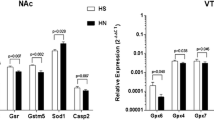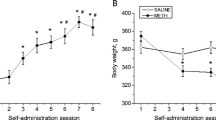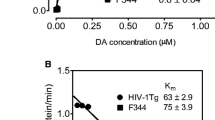Abstract
HIV infection and methamphetamine (Meth) abuse both may lead to oxidative stress. This study used HIV-1 transgenic (HIV-1Tg) rats to investigate the independent and combined effects of HIV viral protein expression and low dose repeated Meth exposure on the glutathione (GSH)-centered antioxidant system and oxidative stress in the brain. Total GSH content, gene expression and/or enzymatic activities of glutamylcysteine synthetase (GCS), gamma-glutamyltransferase (GGT), glutathione reductase (GR), glutathione peroxidase (GPx), glutaredoxin (Glrx), and glutathione-s-transferase (GST) were measured. The protein expression of cystine transporter (xCT) and oxidative stress marker 4-hydroxynonenal (HNE) were also analyzed. Brain regions studied include thalamus, frontal and remainder cortex, striatum, cerebellum and hippocampus. HIV-1Tg rats and Meth exposure showed highly regional specific responses. In the F344 rats, the thalamus had the highest baseline GSH concentration and potentially higher GSH recycle rate. HIV-1Tg rats showed strong transcriptional responses to GSH depletion in the thalamus. Both HIV-1Tg and Meth resulted in decreased GR activity in thalamus, and decreased Glrx activity in frontal cortex. However, the increased GR and Glrx activities synergized with increased GSH concentration, which might have partially prevented Meth-induced oxidative stress in striatum. Interactive effects between Meth and HIV-1Tg were observed in thalamus on the activities of GCS and GGT, and in thalamus and frontal cortex on Glrx activity and xCT protein expression. Findings suggest that HIV viral protein and low dose repeated Meth exposure have separate and combined effects on the brain’s antioxidant capacity and the oxidative stress response that are regional specific.


Similar content being viewed by others
References
Acikgoz O, Gonenc S, Kayatekin BM, Uysal N, Pekcetin C et al (1998) Methamphetamine causes lipid peroxidation and an increase in superoxide dismutase activity in the rat striatum. Brain Res 813:200–202
Ajjimaporn A, Shavali S, Ebadi M, Govitrapong P (2008) Zinc rescues dopaminergic SK-N-SH cell lines from methamphetamine-induced toxicity. Brain Res Bull 77:361–366
Albrecht P, Lewerenz J, Dittmer S, Noack R, Maher P, Methner A (2010) Mechanisms of oxidative glutamate toxicity: the glutamate/cystine antiporter system xc- as a neuroprotective drug target. CNS Neurol Disord Drug Targets 9:373–382
Aoyama K, Watabe M, Nakaki T (2008) Regulation of neuronal glutathione synthesis. J Pharmacol Sci 108:227–238
Bandaru VV, McArthur JC, Sacktor N, Cutler RG, Knapp EL et al (2007) Associative and predictive biomarkers of dementia in HIV-1-infected patients. Neurology 68:1481–1487
Banerjee A, Zhang X, Manda KR, Banks WA, Ercal N (2010) HIV proteins (gp120 and Tat) and methamphetamine in oxidative stress-induced damage in the brain: potential role of the thiol antioxidant N-acetylcysteine amide. Free Radic Biol Med 48:1388–1398
Bannai S, Tateishi N (1986) Role of membrane transport in metabolism and function of glutathione in mammals. J Membr Biol 89:1–8
Basselin M, Ramadan E, Igarashi M, Chang L, Chen M et al (2011) Imaging upregulated brain arachidonic acid metabolism in HIV-1 transgenic rats. J Cereb Blood Flow Metab 31:486–493
Bronowicka-Adamska P, Zagajewski J, Czubak J, Wróbel M (2011) RP-HPLC method for quantitative determination of cystathionine, cysteine and glutathione: An application for the study of the metabolism of cysteine in human brain. J Chromatogr B Analyt Technol Biomed Life Sci Epub May 23
Castagna A, Le Grazie C, Accordini A, Giulidori P, Cavalli G et al (1995) Cerebrospinal fluid S-adenosylmethionine (SAMe) and glutathione concentrations in HIV infection: effect of parenteral treatment with SAMe. Neurology 45:1678–1683
Chang L, Ernst T, Speck O, Grob CS (2005) Additive effects of HIV and chronic methamphetamine use on brain metabolite abnormalities. Am J Psychiatry 162:361–369
Chen J, Lindmark-Mansson H, Gorton L, Akesson B (2003) Total antioxidant capacity of bovine milk as assayed by spectrophotometric and amperometric methods. Int Dairy J 13:927–935
Conrad M, Sato H (2011) The oxidative stress-inducible cystine/glutamate antiporter, system x (c) (-): cystine supplier and beyond. Amino Acids Epub ahead of print
Dai F, Yang JY, Gu PF, Hou Y, Wu CF (2006) Effect of drug-induced ascorbic acid release in the striatum and the nucleus accumbens in hippocampus-lesioned rats. Brain Res 1125:163–170
Daily D, Vlamis-Gardikas A, Offen D, Mittelman L, Melamed E et al (2001) Glutaredoxin protects cerebellar granule neurons from dopamine-induced apoptosis by activating NF-kappa B via Ref-1. J Biol Chem 276:1335–1344
Diotte NM, Xiong Y, Gao J, Chua BH, Ho YS (2009) Attenuation of doxorubicin-induced cardiac injury by mitochondrial glutaredoxin 2. Biochim Biophys Acta 1793:427–438
Doorn JA, Petersen DR (2002) Covalent modification of amino acid nucleophiles by the lipid peroxidation products 4-hydroxy-2-nonenal and 4-oxo-2-nonenal. Chem Res Toxicol 15:1445–1450
Ernst T, Jiang CS, Nakama H, Buchthal S, Chang L (2010) Lower brain glutamate is associated with cognitive deficits in HIV patients: a new mechanism for HIV-associated neurocognitive disorder. J Magn Reson Imaging 32:1045–1053
Everall IP, Hudson L, Kerwin RW (1997) Decreased absolute levels of ascorbic acid and unaltered vasoactive intestinal polypeptide receptor binding in the frontal cortex in acquired immunodeficiency syndrome. Neurosci Lett 224:119–122
Farabee D, Prendergast M, Cartier J (2002) Methamphetamine use and HIV risk among substance-abusing offenders in California. J Psychoactive Drugs 34:295–300
Flora G, Lee YW, Nath A, Maragos W, Hennig B, Toborek M (2002) Methamphetamine-induced TNF-alpha gene expression and activation of AP-1 in discrete regions of mouse brain: potential role of reactive oxygen intermediates and lipid peroxidation. Neruomol Med 2:71–85
Franklin CC, Backos DS, Mohar I, White CC, Forman HJ, Kavanagh TJ (2009) Structure, function, and post-translational regulation of the catalytic and modifier subunits of glutamate cysteine ligase. Mol Aspects Med 30:86–98
Gluck MR, Moy LY, Jayatilleke E, Hogan KA, Manzino L, Sonsalla PK (2001) Parallel increases in lipid and protein oxidative markers in several mouse brain regions after methamphetamine treatment. J Neurochem 79:152–160
Gonzalez P, Tunon MJ, Manrique V, Garcia-Pardo LA, Gonzalez J (1989) Changes in hepatic cytosolic glutathione S-transferase enzymes induced by clotrimazole treatment in rats. Clin Exp Pharmacol Physiol 16:867–871
Griffith OW (1999) Biologic and pharmacologic regulation of mammalian glutathione synthesis. Free Radic Biol Med 27:922–935
Hag AM, Kristoffersen US, Pedersen SF, Gutte H, Lebech AM, Kjaer A (2009) Regional gene expression of LOX-1, VCAM-1, and ICAM-1 in aorta of HIV-1 transgenic rats. PLoS One 4:e8170
Harold C, Wallace T, Friedman R, Gudelsky G, Yamamoto B (2000) Methamphetamine selectively alters brain glutathione. Eur J Pharmacol 400:99–102
Kass MD, Liu X, Vigorito M, Chang L, Chang SL (2010) Methamphetamine-induced behavioral and physiological effects in adolescent and adult HIV-1 transgenic rats. J Neuroimmune Pharmacol 5:566–573
Kenchappa RS, Ravindranath V (2003) Glutaredoxin is essential for maintenance of brain mitochondrial complex I: studies with MPTP. FASEB J: Off Publ Fed Am Soc Exp Biol 17:717–719
Kruman II, Nath A, Mattson MP (1998) HIV-1 protein Tat induces apoptosis of hippocampal neurons by a mechanism involving caspase activation, calcium overload, and oxidative stress. Exp Neurol 154:276–288
Langford D, Adame A, Grigorian A, Grant I, McCutchan JA et al (2003) Patterns of selective neuronal damage in methamphetamine-user AIDS patients. J Acquir Immune Defic Syndr 34:467–474
Langford D, Grigorian A, Hurford R, Adame A, Crews L, Masliah E (2004) The role of mitochondrial alterations in the combined toxic effects of human immunodeficiency virus Tat protein and methamphetamine on calbindin positive-neurons. J Neurovirol 10:327–337
Lee DW, Kim SY, Lee T, Nam YK, Ju A et al (2012) Ex vivo detection for chronic ethanol consumption-induced neurochemical changes in rats. Brain Res 1429:134–144
Lewerenz J, Maher P, Methner A (2012) Regulation of xCT expression and system x (c) (-) function in neuronal cells. Amino Acids 42:171–179
Liu X, Chang L, Vigorito M, Kass M, Li H, Chang SL (2009) Methamphetamine-induced behavioral sensitization is enhanced in the HIV-1 transgenic rat. J Neuroimmune Pharmacol 4:309–316
Maragos WF, Young KL, Turchan JT, Guseva M, Pauly JR et al (2002) Human immunodeficiency virus-1 Tat protein and methamphetamine interact synergistically to impair striatal dopaminergic function. J Neurochem 83:955–963
Mattson MP, Haughey NJ, Nath A (2005) Cell death in HIV dementia. Cell Death Differ 12(Suppl 1):893–904
Meister A (1983) Selective modification of glutathione metabolism. Science 220:472–477
Meister A, Tate SS, Griffith OW (1981) Gamma-glutamyl transpeptidase. Methods Enzymol 77:237–253
Morris D, Guerra C, Donohue C, Oh H, Khurasany M, Venketaraman V (2012) Unveiling the mechanisms for decreased glutathione in individuals with HIV infection. Clin Dev Immunol 2012:734125
Moszczynska A, Yamamoto BK (2011) Methamphetamine oxidatively damages parkin and decreases the activity of 26S proteasome in vivo. J Neurochem 116:1005–1017
Nemoto T, Operario D, Soma T (2002) Risk behaviors of Filipino methamphetamine users in San Francisco: implications for prevention and treatment of drug use and HIV. Public Health Rep 117(Suppl 1):S30–S38
Panee J, Stoytcheva ZR, Liu W, Berry MJ (2007) Selenoprotein H is a redox-sensing high mobility group family DNA-binding protein that up-regulates genes involved in glutathione synthesis and phase II detoxification. J Biol Chem 282:23759–23765
Pendyala G, Trauger SA, Siuzdak G, Fox HS (2011) Short communication: quantitative proteomic plasma profiling reveals activation of host defense to oxidative stress in chronic SIV and methamphetamine comorbidity. AIDS Res Hum Retrovir 27:179–182
Peng J, Vigorito M, Liu X, Zhou D, Wu X, Chang SL (2010) The HIV-1 transgenic rat as a model for HIV-1 infected individuals on HAART. J Neuroimmunol 218:94–101
Reid W, Sadowska M, Denaro F, Rao S, Foulke J Jr et al (2001) An HIV-1 transgenic rat that develops HIV-related pathology and immunologic dysfunction. Proc Natl Acad Sci U S A 98:9271–9276
Rice ME, Russo-Menna I (1998) Differential compartmentalization of brain ascorbate and glutathione between neurons and glia. Neuroscience 82:1213–1223
Riddle DR (2007) Brain aging: models, methods, and mechanisms
Sacktor N, Haughey N, Cutler R, Tamara A, Turchan J et al (2004) Novel markers of oxidative stress in actively progressive HIV dementia. J Neuroimmunol 157:176–184
Saeed U, Durgadoss L, Valli RK, Joshi DC, Joshi PG, Ravindranath V (2008) Knockdown of cytosolic glutaredoxin 1 leads to loss of mitochondrial membrane potential: implication in neurodegenerative diseases. PLoS One 3:e2459
Semple SJ, Patterson TL, Grant I (2002) Motivations associated with methamphetamine use among HIV + men who have sex with men. J Subst Abus Treat 22:149–156
Tang H, Lu D, Pan R, Qin X, Xiong H, Dong J (2009) Curcumin improves spatial memory impairment induced by human immunodeficiency virus type 1 glycoprotein 120 V3 loop peptide in rats. Life Sci 85:1–10
Tietze F (1970) Disulfide reduction in rat liver. I. Evidence for the presence of nonspecific nucleotide-dependent disulfide reductase and GSH-disulfide transhydrogenase activities in the high-speed supernatant fraction. Arch Biochem Biophys 138:177–188
Turchan J, Pocernich CB, Gairola C, Chauhan A, Schifitto G et al (2003) Oxidative stress in HIV demented patients and protection ex vivo with novel antioxidants. Neurology 60:307–314
Velazquez I, Plaud M, Wojna V, Skolasky R, Laspiur JP, Melendez LM (2009) Antioxidant enzyme dysfunction in monocytes and CSF of Hispanic women with HIV-associated cognitive impairment. J Neuroimmunol 206:106–111
Vigorito M, LaShomb AL, Chang SL (2007) Spatial learning and memory in HIV-1 transgenic rats. J Neuroimmune Pharmacol 2:319–328
Vikulina T, Fan X, Yamaguchi M, Roser-Page S, Zayzafoon M et al (2010) Alterations in the immuno-skeletal interface drive bone destruction in HIV-1 transgenic rats. Proc Natl Acad Sci U S A 107:13848–13853
Watabe M, Aoyama K, Nakaki T (2008) A dominant role of GTRAP3-18 in neuronal glutathione synthesis. J Neurosci 28:9404–9413
White CC, Viernes H, Krejsa CM, Botta D, Kavanagh TJ (2003) Fluorescence-based microtiter plate assay for glutamate-cysteine ligase activity. Anal Biochem 318:175–180
Wu CW, Ping YH, Yen JC, Chang CY, Wang SF et al (2007) Enhanced oxidative stress and aberrant mitochondrial biogenesis in human neuroblastoma SH-SY5Y cells during methamphetamine induced apoptosis. Toxicol Appl Pharmacol 220:243–251
Yamamoto BK, Zhu W (1998) The effects of methamphetamine on the production of free radicals and oxidative stress. J Pharmacol Exp Ther 287:107–114
Zhang X, Banerjee A, Banks WA, Ercal N (2009) N-Acetylcysteine amide protects against methamphetamine-induced oxidative stress and neurotoxicity in immortalized human brain endothelial cells. Brain Res 1275:87–95
Acknowledgments
This study was made possible by grants from the National Institutes of Health (NIH): U54NS56883, 5P20RR016467-11 and 8P20GMl03466-11 (INBRE II), 5G12RR003061 and 8G12MD007601 (RCMI/BRIDGES), 2K24DA016170 (to LC) and 2 K02016149 (to SLC). Its contents are solely the responsibility of the authors and do not necessarily represent the official views of the NIH.
Author information
Authors and Affiliations
Corresponding author
Additional information
Xiaosha Pang and Jun Panee contributed equally to this work.
Rights and permissions
About this article
Cite this article
Pang, X., Panee, J., Liu, X. et al. Regional Variations of Antioxidant Capacity and Oxidative Stress Responses in HIV-1 Transgenic Rats With and Without Methamphetamine Administration. J Neuroimmune Pharmacol 8, 691–704 (2013). https://doi.org/10.1007/s11481-013-9454-8
Received:
Accepted:
Published:
Issue Date:
DOI: https://doi.org/10.1007/s11481-013-9454-8




